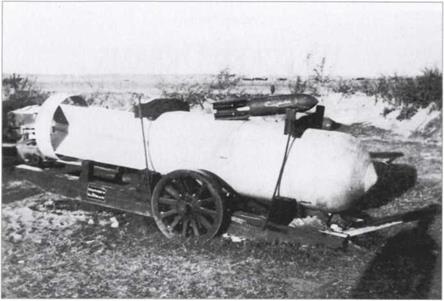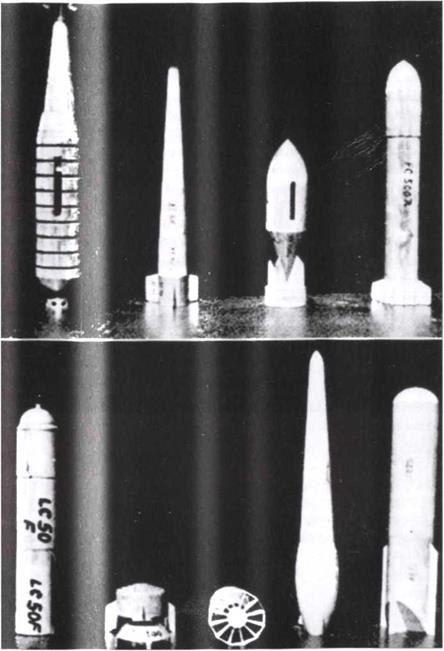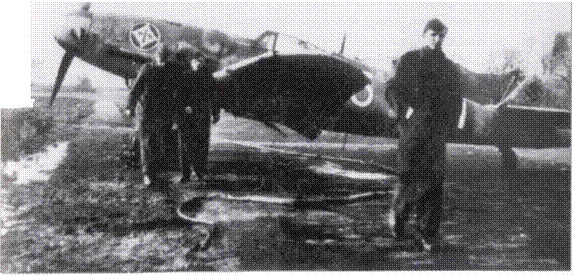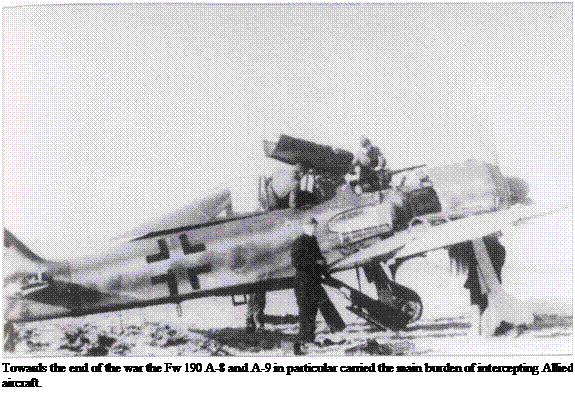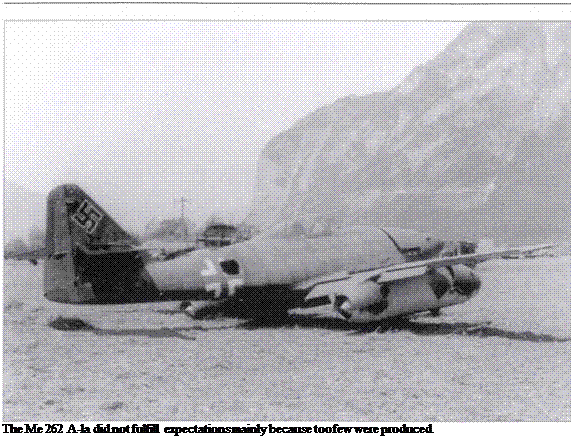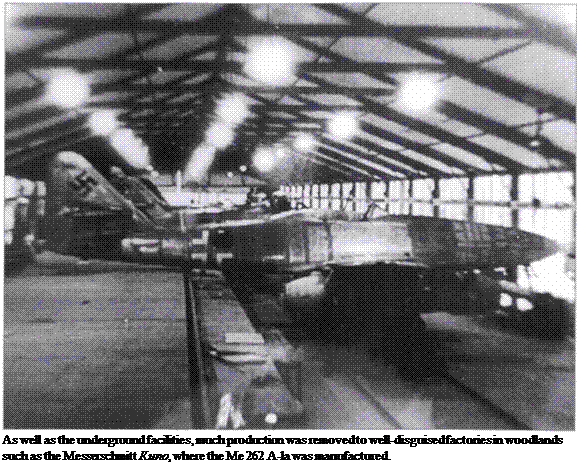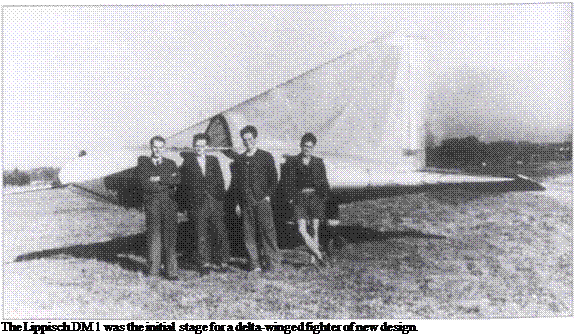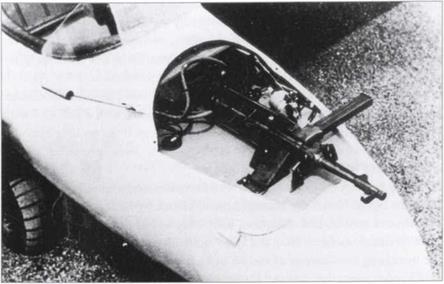As defeat loomed in the spring of 1944, a wave of changes was introduced into the structure of Luftwaffe armaments. These changes were accompanied by a major reorganisation in personnel. The Reich Aviation Ministry (RLM) ceded most of its influence in the sphere of aircraft development and production and other aerial weapons to the Reich Minister for Armaments and War Production. Generalfeldmarschall Erhard Milch, General – Luftzeugmeister (QM-General for Aircraft Supply) at RLM, was replaced in
that capacity by Dipl. Ing. Karl-Otto Saur, Speer’s head of planning, as Chief of Staff. Saur s influence on the Jagerstab, the fighter emergency programme and the later Riistungsstab was very considerable. Nobody by-passed him, and he became the eminence gris of Luftwaffe armament.
It came as a surprise that, despite the Allied air bombardment of Reich territory and occupied western Europe, aircraft production was not only not weakened to the extent that the Allies expected, but actually expanded on a scale considered impossible. This was achieved by the Jagerstab (Fighter Staff) which had been introduced for a six-month trial period on 1 March 1944 by Reich Minister Speer.
This significant sector of the armaments economy was stripped of all bureaucracy, and industry received binding instructions in accordance with the Fiihrer-principle, often being subjected to radical and energetic controls. The Jagerstab was also responsible for carrying out immediate repairs to aircraft factories damaged by enemy action, and where necessary for relocating them in forests or underground facilities. For this purpose the Jagerstab had absolute authority over the workforce to the exclusion of all other authorities. This factor, and a tightening of aircraft production by reducing the number of types being produced to the most efficient standard versions, led to a rise in the monthly output of completed machines from the beginning of 1944.
The management of the Jagerstab was in the hands of Speer and Milch. Dipl. Ing. Schlempp was responsible for ‘building measures’. SS-Gruppenfuhrer Dr. Ing. Kammler administered ‘special production measures’, and Dr. Ing. Wagner the planning stages. It was thanks to these leaders that within a very short time the Jagerstab was able to force through the planned production programme at a fierce pace.
Hitler’s edict of 19 June 1944 called for the comprehensive concentration of armaments and war production, and provided Speer with a considerable growth in his personal powers. This led to the Jagerstab not only having independent production responsibility for everything from individual parts to whole warplanes, but also being involved in the procurement process. Accordingly, from the summer of 1944, the hitherto long drawn-out decision processes since time immemorial the tradition at RLM were abolished and the heavy hand introduced to obtain desired decisions in the shortest possible time. The Jagerstab was now also able to lay down the requirements in personnel and to call upon all conceivable resources to meet production targets.
On 1 July 1944 the jurisdiction of the Jagerstab was made manifest for the first time during a conference with Reichsmarschall Goring when it was laid down that with immediate effect 3,800 fighters, including 500 Me 262 jets, must come off the lines monthly. Consideration was also given to building 400 heavily-armed fighter-bombers (Jabos) and 500 night fighters. In order to
reduce the endless flood of applications for changes to prototypes, on 3 July 1944 the Luftwaffe and industry were ordered to do whatever possible to curtail conversions and the redesigning of new aircraft in order to have the fewest changes.
Again, on 20 July 1944, Hitler reiterated that for German industry, in all areas of armaments including the production of new operational aircraft, the aim was the highest possible output in the shortest time. He put Heinkel director Karl Freytag, renowned for his ability to get things done, in charge of aircraft production, while the equally well-versed Dr Walter Werner looked after the piston-engine and turbine side of things. On 27 July the post of GLZM (Director of Aircraft Production and Supply) at the RLM held by Milch was abolished and replaced by the Office of Chief of Aviation Technical Equipment (Chief-TLR). This shortened the command chain, got decisions made quicker and was intended to bring improved weapons and aircraft to operational readiness within the shortest possible time. The Chief-TLR reported direcdy to the Chief of the Luftwaffe General Staff.
By 1 September 1944 the numerous test centres were under uniform control and development tasks were better distributed. Test Centre Command (KdE),
the Luftwaffe Technical Academy and the research organisation and all its associated centres were subordinated to Chief-TLR. Aircraft production was to aim for a tightening of all industrial processes throughout for the highest possible quality. The rigorous measures introduced to raise production brought at first only partial success, and, despite turning out new aircraft at an unprecedented tempo and scale, Speer and Saur were not satisfied.
In another discussion between Goring and Saur on 12 December 1944, the Reichsmarschall set out his ideas for a programme to be realised in the coming months involving the future monthly production of 1,500 He 162s and Me 262s. The Bf 109 G-10 and K-4, and the Fw 190 A-8, A-9 and D-9 would make way for 2,000 Та 152s monthly, while a further 150 Me 163s and Me 263s were planned for air defence. From January 1945 besides 300 Do 335s, 100 Ju 388s were to be produced monthly as Jabos, night fighters and for long-range reconnaissance. The Ar 234 B-2 was to be the standard jet bomber. The hope was that 500 of these machines might be sufficient not only to equip several bomber squadrons, but also for reconnaissance and as night fighters. In all, from January
1945 it was intended to produce 6,000 aircraft monthly for front-line service and up to 400 training machines.
Saur spoke out in favour of giving the Me 262 and He 162 the highest priority in production and delivery to squadrons, the planned supply of materials, equipment, transport to the manufacturer and transfer to the front. Night fighters were to be given a lower priority. Their production should fall to 200 machines monthly by mid-1945 and then rise slowly to 380 again. All Jabo production would be superseded by jet fighters and replaced by the twin-engined Do 335 in due course. Future bomber production would be cut back. In place of 600 Fw 190 F aircraft, only 350 Та 152s were now being considered for offensive missions. That was not enough: jet aircraft, especially the Me 262 A-la and the single turbine He 162 A-l (MK 108 30-mm guns) and A-2 (MG 151/20), were to replace all piston-engined aircraft. Because of the prevailing fuel situation, aircraft such as the Ar 234 or Ju 287 were to play only a minor role from the beginning of 1945. The remaining jet or rocket models, for example the Go 229 or Ju 248 (Me 263) never reached series production. Although the attempt was made, the endeavour failed because many fuselages lacked equipment or engines.
Soon after the appointment of the first Chief-TLR and the later Piihrer edicts to concentrate production, the former Jagerstab was seen as obsolete. A more influential body was to be introduced in which Speer, building on the positive experience gained with the Jagerstab, planned an armaments staff (Riistungsstab) omnipotent in every respect and responsible for equipping the entire Wehrmacht and Waffen-SS. Under its control the Luftwaffe would have a comprehensive aircraft and flak programme at the earliest opportunity. Speer would head the Riistungsstab with Saur as his deputy and chief of staff: General-Staff Engineer Roluf Lucht was responsible for the day-to-day decisions. SS-Gruppenfuhrer Kammler remained in charge of special planning measures such as building bomb-proof aircraft and engine factories. The Riistungsstab would not only coordinate individual units better, but even handle assembly and transport to smooth the way, and on 1 August 1944 Speer cancelled his directive of 1 March 1944 establishing the Jagerstab.
Amongst the Riistungsstab’s surprising early decisions was an order to series produce the Ju 287 and expand Ar 234 production. At least 1,000 fight jet fighters (He 162 A-l and A-2) were now projected monthly, together with the highest possible number of Me 262s, presumably at Hitlers intervention. In the remaining months, these very incisive measures by the Riistungsstab made possible a reasonable output of completed aircraft despite Allied air raids, although the lack of fuel and destruction of communications had an unfavourable effect on overall production.
Only from January 1945 did orderly production come closer each week to coming apart at the seams, yet armaments planning was not to fall apart
completely until Reich territory began to be lost. Even in April 1945 Bf 109s, Me 262s and He 219s were still emerging from underground centres, but those in charge were by then heading for an uncertain future. The Rechlin test centre s personnel, for example, ended their war at Oberpfaffenhofen near Munich, while surviving parts of the RLM and the Riistungsstab had been dispersed and lost contact. For them the war was over: the time of captivity had begun.











